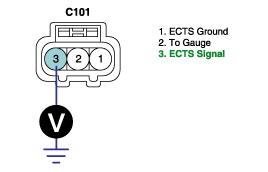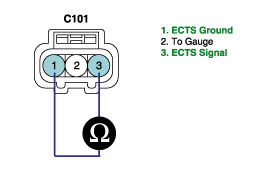Monitor "ECTS" item on the service data.


The Engine Coolant Temperature(ECT) Sensor measures the temperature of engine coolant. The Engine Coolant Temperature (ECT) Sensor is located near the thermostat housing of the cylinder head. ECT Sensor is a thermistor (A Variable Resistor that Changes Along with ECT) in series with a fixed resistor in the Engine Control Module (PCM). The PCM applies 5 volts to the ECT sensor. The PCM monitors the voltage across the ECT sensor and converts it into a temperature reading. When the engine is cold the ECT sensor resistance is high, and when the engine is warm the ECT sensor resistance is low. Therefore, when the engine is cold the PCM will receive a high voltage input, and when the engine is warm the PCM will receive a low voltage input. The signal from ECT sensor is used for Injection, ignition timing, idle speed and cooling fan control.
The Engine Coolant Temperature High Rationality Diagnostic checks for unusually high engine coolant temperatures under normal operating loads.
PCM monitors difference between the startup and current coolant temperature and compares agaist the threshold while enable condition is met. If the PCM detects that the coolant temperature exceeds the limit under normal operating condition, PCM determines that a fault exists and a DTC is stored.
Item | Detecting Condition | Possible cause | |||||
DTC Strategy | ● This diagnostic introduces a calibratable delay and simultaneously looks out for excessive engine loads. Once the delay period passes and excessive loads have not been experienced, the diagnostic checks whether the undefaulted coolant temperature has exceeded a maximum threshold in order to make a PASS/FAIL determination. | ● Poor connection ● Lack of engine coolant ● Water pump ● ECTS ● PCM | |||||
Enable Conditions | ● Engine Running status ● No disabling faults present ● Coolant Sensor within range ● Undefaulted Coolant Temp ≥ 50℃( 122 °F) ● Undefaulted IAT ≥ 35℃( 95 °F) ● Soak time ≥ 360min or Undefaulted Coolant temp ≤ 45℃( 113 °F) | ||||||
Thresh old value | ● Coolant temperature ≥ 110℃ (230 °F) ● Average airflow〈 30 g/s and filtered airflow〈 50 g/s. | ||||||
Diagnosis Time | ● Continuous (More than 12.5 sec.failure for every 15 sec.test) | ||||||
MIL On Condition | ● 2 driving cycles | ||||||

The output signals of IATS & ECTS change smoothly without any rapid changes. Those have almost same characteristic signal during the early period after start. It means that the temperatures of intake air and engine coolant are depended on the temperature of atmosphere. Meanwhile, during the warming up, the output signal of ECTS is going up increasingly. but, the output signal of IATS changes a little bit. even it may not change almost. It means that the heat of engine does not affect on the temperature of intake air.
Temp. (℃/℉) | Resistance (kΩ) | Temp. (℃/℉) | Resistance (kΩ) | ||||
-40(-40) | 48.14 | 40(104) | 1.15 | ||||
-20(-4) | 14.13 ~ 16.83 | 60(140) | 0.59 | ||||
0(32) | 5.79 | 80(176) | 0.32 | ||||
20(68) | 2.31 ~ 2.59 |
|
|

IG "OFF" & connect scantool.
ENG "ON" and warm -up the engine to normal operating temperature.
Monitor "ECTS" item on the service data.

Is the "ECTS" data displayed correctly ?

▶ Fault is intermittent caused by poor contact in the sensor’s and/or PCM’s connector or was repaired and PCM memory was not cleared. Thoroughly check connectors for looseness, poor connection, ending, corrosion, contamination, deterioration, or damage. Repair or replace as necessary and go to "Verification of Vehicle Repair" procedure

▶ Go to "Terminal and connector inspection" procedure
Many malfunctions in the electrical system are caused by poor harness and terminals. Faults can also be caused by interference from other electrical systems, and mechanical or chemical damage.
Thoroughly check connectors for looseness, poor connection, bending, corrosion, contamination, deterioration, or damage.
Has a problem been found?

▶ Repair as necessary and go to "Verification of Vehicle Repair" procedure

▶ Go to "Signal Circuit Inspection" procedure.
IG "OFF" and disconnect ECTS connector.
IG "ON" & ENG "OFF"
Measure voltage between terminal 3 of ECTS harness connector and chassis ground.
Specification : Approx. 5V

Is the measured voltage within specification ?

▶ Go to "System Inspection" procedure.

▶ Go to "Check short to ground in harness" as follows.
Check short to ground in harness
IG "OFF" and disconnect ECTS connector and PCM connector.
Measure resistance between terminal 3 of ECTS harness connector and chassis ground.
Measure resistance between terminals 1 and 3 of ECTS harness connector.
Specification : Infinite

Is the measured resistance within specification?

▶ Go to "System Inspection" procedure.

▶ Repair short to ground in harness, and go to "Verification of Vehicle Repair" procedure.
Check if Engine coolant level is O.K
Check if that water pump is operating correctly.
Has a problem been found ?

▶ Repair or replace as necessary and then go to "Verification of Vehicle Repair"procedure.

▶ Go to "Component Inspection" procedure.
Check resistance of ECTS
IG "OFF" and disconnect ECTS connector.
Measure resistance between terminal 1 and 3 of ECTS connector. (Component Side)
Temp. (℃/℉) | Resistance (kΩ) | Temp. (℃/℉) | Resistance (kΩ) | ||||
-40(-40) | 48.14 | 40(104) | 1.15 | ||||
-20(-4) | 14.13 ~ 16.83 | 60(140) | 0.59 | ||||
0(32) | 5.79 | 80(176) | 0.32 | ||||
20(68) | 2.31 ~ 2.59 |
|
|

Is the measured resistance within specification ?

▶ Go to "Check PCM" procedure.

▶ Substitute with a known - good ECTS and check for proper operation. If the problem is corrected, replace ECTS and go to "Verification of Vehicle Repair" procedure.
Check PCM
IG "OFF" and connect scantool.
Connect probe to terminal 3 of ECTS harness connector.
IG "ON" and ENG "OFF" and simulation Function on scantool.
Simulate voltage at terminal 3 of ECTS harness connector.

Does the signal value of ECT sensor change according to simulation voltage ?

▶ Thoroughly check connectors for looseness, poor connection, bending, corrosion, contamination, deterioration, or damage. Repair or replace as necessary and go to "Verification of Vehicle Repair" procedure.

▶ Substitute with a known - good PCM and check for proper operation. If the problem is corrected, replace PCM and go to "Verification of Vehicle Repair" procedure.
There is a memory reset function on scantool that can erase optional parts automatically detected and memorized by PCM. After testing PCM on the vehicle, use this function to reuse the PCM on the others
After a repair, it is essential to verify that the fault has been corrected.
Monitor and record the Freeze Frame Data for the Diagnostic Trouble Code(DTC) which has been diagnosed.
Using a Scantool, Clear the DTCs
Operate the vehicle within conditions noted in the freeze frame data or enable conditions
Monitor that all rediness test have been verified as " Complete "
Are any DTCs present ?

▶ Go to the applicable troubleshoooting procedure.

▶ System is performing to specification at this time.